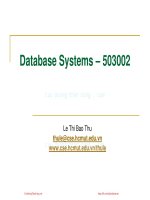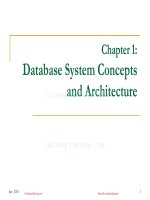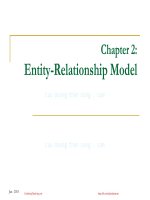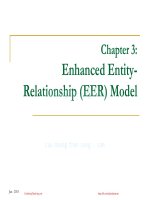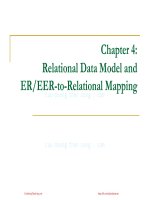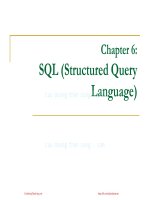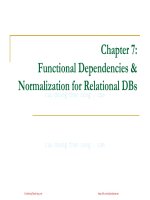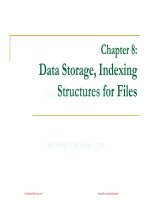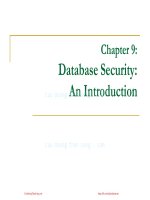cơ sở dữ liệu lê thị bảo thu chương ter 03 eerd sinhvienzone com
Bạn đang xem bản rút gọn của tài liệu. Xem và tải ngay bản đầy đủ của tài liệu tại đây (1.91 MB, 67 trang )
Chapter 3:
Enhanced EntityRelationship (EER) Model
Jan - 2015
CuuDuongThanCong.com
/>
Contents
1
Introduction to Enhanced-ER Model
2
Subclasses, Superclasses, and Inheritance
3
Specialization and Generalization
4
Constraints and Characteristics of Specialization
and Generalization Hierarchies
5
Categories
6
Design Choices, and Formal Definitions
Jan - 2015
CuuDuongThanCong.com
/>
2
Contents
1
Introduction to Enhanced-ER Model
2
Subclasses, Superclasses, and Inheritance
3
Specialization and Generalization
4
Constraints and Characteristics of Specialization
and Generalization Hierarchies
5
Categories
6
Design Choices, and Formal Definitions
Jan - 2015
CuuDuongThanCong.com
/>
3
Introduction to Enhanced-ER Model
(1)
Enhanced ER or Extended ER (EER)
model
Created to design more accurate database
schemas
Jan - 2015
Reflect the data properties and constraints more
precisely
More complex requirements than traditional
applications
CuuDuongThanCong.com
/>
4
Introduction to Enhanced-ER Model
(2)
EER model includes all modeling concepts of
the ER model
In addition, EER includes:
Subclasses and superclasses
Specialization and generalization
Category or union type
Attribute and relationship inheritance
EER diagrams
Jan - 2015
Diagrammatic technique for displaying these concepts
in an EER schema
CuuDuongThanCong.com
/>
5
Contents
1
Introduction to Enhanced-ER Model
2
Subclasses, Superclasses, and Inheritance
3
Specialization and Generalization
4
Constraints and Characteristics of Specialization
and Generalization Hierarchies
5
Categories
6
Design Choices, and Formal Definitions
Jan - 2015
CuuDuongThanCong.com
/>
6
Subclasses, Superclasses & Inheritance
(1)
Subtype or subclass of an entity type
Terms for relationship between a superclass and any
one of its subclasses
Subgroupings of entities that are meaningful
ro rang
Represented explicitly because of their significance to the
database application
Superclass/subclass
Supertype/subtype
Class/subclass
A class/subclass relationship is often called an IS-A (ISAN) relationship.
Jan - 2015
CuuDuongThanCong.com
/>
7
Subclasses, Superclasses & Inheritance
(2)
Ex: EMPLOYEE may be further grouped into
SECRETARY, ENGINEER, MANAGER,
TECHNICIAN, SALARIED_EMPLOYEE,
HOURLY_EMPLOYEE, and so on.
Jan - 2015
Set of entities in each subgroups is a subset of the
EMPLOYEE entity set.
Each is called a subclass of EMPLOYEE
EMPLOYEE is the superclass for each of these
subclasses
CuuDuongThanCong.com
/>
8
EER diagram notation to represent subclasses &
specialization
Jan - 2015
CuuDuongThanCong.com
/>
9
Subclasses, Superclasses & Inheritance
(3)
A subclass member is the same as the entity in the
superclass, but in a distinct specific role
An entity cannot exist in the database merely by
being a member of a subclass; it must also be a
member of the superclass
A member of a superclass can be optionally
included as a member of some of its subclasses
It is not necessary that every entity in a superclass
be a member of some subclass
Superclass/subclass relationship is one-to-one (1:1)
Jan - 2015
CuuDuongThanCong.com
/>
10
Subclasses, Superclasses & Inheritance
(4)
Subclass entity inherits all attributes and
relationships of superclass
Notice that a subclass, with its own specific
(or local) attributes and relationships together
with all the attributes and relationships it
inherits from the superclass, can be
considered an entity type in its own right.
Jan - 2015
CuuDuongThanCong.com
/>
11
Contents
1
Introduction to Enhanced-ER Model
2
Subclasses, Superclasses, and Inheritance
3
Specialization and Generalization
4
Constraints and Characteristics of Specialization
and Generalization Hierarchies
5
Categories
6
Design Choices, and Formal Definitions
Jan - 2015
CuuDuongThanCong.com
/>
12
Specialization
Specialization
Process of defining a set of subclasses of an entity
type, called superclass
Defined on the basis of some distinguishing
characteristic of the entities in the superclass
May have several specializations of the same entity
type based on different distinguishing characteristics
Subclass can have its own:
Jan - 2015
Specific attributes (local attributes)
Specific relationship types
CuuDuongThanCong.com
/>
13
Example of a Specialization
Jan - 2015
CuuDuongThanCong.com
/>
14
Instances of a specialization
Jan - 2015
CuuDuongThanCong.com
/>
15
Generalization
Reverse process of Specialization
Generalize several entity types which have
some common features into a single
superclass
Original entity types are special subclasses
Generalization
Jan - 2015
Process of defining a generalized entity type from
the given entity types
CuuDuongThanCong.com
/>
16
Example of a Generalization
Jan - 2015
CuuDuongThanCong.com
/>
17
Specialization and Generalization (1)
Diagrammatic notation sometimes used to
distinguish between generalization and
specialization
Jan - 2015
Arrow pointing to the generalized superclass
represents a generalization
Arrows pointing to the specialized subclasses
represent a specialization
We do not use this notation because it is often
subjective as to which process is more appropriate for
a particular situation
We advocate not drawing any arrows in these
situations
CuuDuongThanCong.com
/>
18
Specialization and Generalization (2)
Data Modeling with Specialization and
Generalization
Jan - 2015
A superclass or subclass represents a set of
entities
Shown in rectangles in EER diagrams (as are
entity types)
Sometimes, all entity sets are simply called
classes, whether they are entity types,
superclasses, or subclasses
CuuDuongThanCong.com
/>
19
Contents
1
Introduction to Enhanced-ER Model
2
Subclasses, Superclasses, and Inheritance
3
Specialization and Generalization
4
Constraints and Characteristics of
Specialization and Generalization Hierarchies
5
Categories
6
Design Choices, and Formal Definitions
Jan - 2015
CuuDuongThanCong.com
/>
20
Constraints and Characteristics of
Specialization and Generalization Hierarchies
Constraints that apply to a single specialization
or a single generalization
Differences between specialization/
generalization lattices and hierarchies
Jan - 2015
CuuDuongThanCong.com
/>
21
Constraints on Specialization and
Generalization (1)
Determine subclass:
Jan - 2015
Predicate-defined (or condition-defined)
subclasses
Attribute-defined specialization
User-defined
CuuDuongThanCong.com
/>
22
Constraints on Specialization and
Generalization (2)
If we can determine exactly those entities that
will become members of each subclass by a
condition, the subclasses are called
predicate-defined (or condition-defined)
subclasses
Jan - 2015
Condition is a constraint that determines subclass
members
Display a predicate-defined subclass by writing
the predicate condition next to the line attaching
the subclass to its superclass
CuuDuongThanCong.com
/>
23
Constraints on Specialization and
Generalization (3)
If all subclasses in a specialization have
membership condition on same attribute of
the superclass, specialization is called an
attribute defined-specialization
Jan - 2015
Attribute is called the defining attribute of the
specialization
Ex: JobType is the defining attribute of the
specialization {SECRETARY, TECHNICIAN,
ENGINEER} of EMPLOYEE
CuuDuongThanCong.com
/>
24
EER diagram notation for an attributedefined specialization on JobType
Defining attribute
Defining predicate
Predicate-defined
/condition-defined)
subclasses
Jan - 2015
CuuDuongThanCong.com
/>
25
